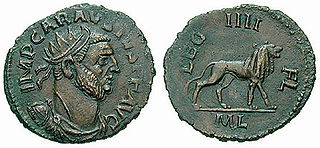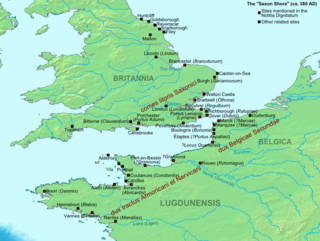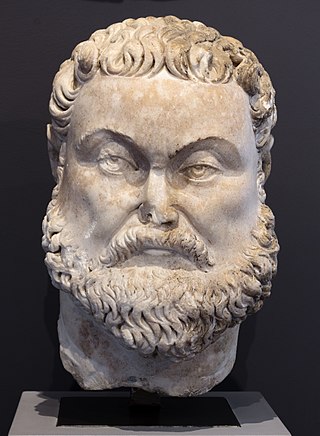
The 3rd century was the period from AD 201 to AD 300 (CCC) in accordance with the Julian calendar.
The 300s decade ran from January 1, 300, to December 31, 309.
The 400s decade ran from January 1, 400, to December 31, 409.

Year 286 (CCLXXXVI) was a common year starting on Friday of the Julian calendar. At the time, it was known as the Year of the Consulship of Maximus and Aquilinus. The denomination 286 for this year has been used since the early medieval period, when the Anno Domini calendar era became the prevalent method in Europe for naming years.
The 270s decade ran from January 1, 270, to December 31, 279.
The 230s decade ran from January 1, 230, to December 31, 239.
The 290s decade ran from January 1, 290, to December 31, 299.
The 250s was a decade that ran from January 1, 250, to December 31, 259.
The 260s decade ran from January 1, 260, to December 31, 269.
The 280's decade ran from January 1, 280, to December 31, 289.

Year 304 (CCCIV) was a leap year starting on Saturday of the Julian calendar. It was known in the Roman Empire as the Year of the Consulship of Diocletian and Maximian. The denomination 304 for this year has been used since the early medieval period, when the Anno Domini calendar era became the prevalent method in Europe for naming years.

Year 290 (CCXC) was a common year starting on Wednesday of the Julian calendar. In the Roman Empire, it was known as the Year of the Consulship of Valerius and Valerius. The denomination 290 for this year has been used since the early medieval period, when the Anno Domini calendar era became the prevalent method in Europe for naming years.

Year 307 (CCCVII) was a common year starting on Wednesday of the Julian calendar. At the time, it was known as the Year of the Consulship of Severus and Maximinus. The denomination 307 for this year has been used since the early medieval period, when the Anno Domini calendar era became the prevalent method in Europe for naming years.

Flavius Valerius Constantius, also called Constantius I, was a Roman emperor from 305 to 306. He was one of the four original members of the Tetrarchy established by Diocletian, first serving as caesar from 293 to 305 and then ruling as augustus until his death. Constantius was also father of Constantine the Great, the first Christian emperor of Rome. The nickname "Chlorus" was first popularized by Byzantine-era historians and not used during the emperor's lifetime.

Maximian, nicknamed Herculius, was Roman emperor from 286 to 305. He was Caesar from 285 to 286, then Augustus from 286 to 305. He shared the latter title with his co-emperor and superior, Diocletian, whose political brain complemented Maximian's military brawn. Maximian established his residence at Trier but spent most of his time on campaign. In late 285, he suppressed rebels in Gaul known as the Bagaudae. From 285 to 288, he fought against Germanic tribes along the Rhine frontier. Together with Diocletian, he launched a scorched earth campaign deep into Alamannic territory in 288, refortifying the frontier.

Emperor Wu of Jin, personal name Sima Yan, courtesy name Anshi (安世), was a grandson of Sima Yi, nephew of Sima Shi and son of Sima Zhao. He became the first emperor of the Jin dynasty after forcing Cao Huan, last emperor of the state of Cao Wei, to abdicate to him. He reigned from 266 to 290, and after conquering the state of Eastern Wu in 280, was the emperor of a reunified China. Emperor Wu was also known for his extravagance and sensuality, especially after the unification of China; legends boasted of his incredible potency among ten thousand concubines.

Emperor Hui of Jin, personal name Sima Zhong (司馬衷), courtesy name Zhengdu (正度), was the second emperor of the Western Jin dynasty. Emperor Hui was a developmentally disabled ruler, and throughout his reign, there was constant internecine fighting between regents, imperial princes, and his wife Empress Jia Nanfeng for the right to control him, causing great suffering for the people and greatly undermining the stability of the Western Jin dynasty, eventually leading to rebellions of the Five Barbarians that led to Jin's loss of northern and central China and the establishment of the competing Sixteen Kingdoms. He was briefly deposed by his granduncle Sima Lun, who usurped the throne himself, in February 301, but later that year was restored to the throne and continued to be the emperor until January 307, when he was poisoned, likely by the regent Sima Yue.
Sima Liang (司馬亮), courtesy name Ziyi (子翼), formally Prince Wencheng of Ru'nan (汝南文成王), was briefly a regent during the reign of Emperor Hui during the Western Jin dynasty. He was the first of the eight princes commonly associated with the War of the Eight Princes.
Wei Guan, courtesy name Boyu, was a Chinese military general and politician of the state of Cao Wei during the Three Kingdoms period of China. He served under the Jin dynasty after the end of the Three Kingdoms period.
Sima Zhou, courtesy name Zijiang, posthumously known as Prince Wu of Langya (琅琊武王), was an imperial prince and military general of the Jin dynasty of China. He previously served in the state of Cao Wei during the Three Kingdoms period. His grandson, Sima Rui, was the founding emperor of the Eastern Jin dynasty.









